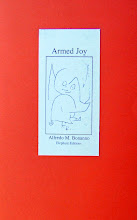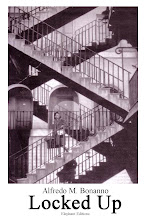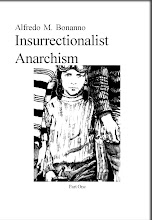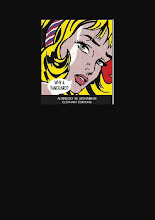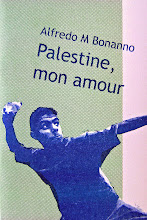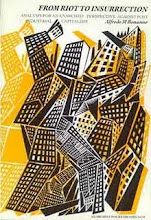Published in Insurrection Issue One 1984
Stop the City was an informative action. Such actions are interesting and useful, though limited, and cannot just be written off as worthless because some comrades don't agree with the methods they use. The problem is deeper than that and is worth going into.
An informative demonstration can conceal itself under some pretty impressive slogans - often to mobilise more people, especially the young marginal fringes - but it remains a demonstration with the aim of making certain facts known. It might call itself Stop the City or Burn the City, but the aim is to draw people's attention to certain things, nothing else. As such it remains a useful but limited action.
To participate in this kind of demonstration in order to push it, from within, towards more violent, revolutionary objectives is a mistake. It becomes the mythical vanguardist entrism of which Lenin and in particular Trotsky were masters. We well know today that anarchists have no interest in entrism. If one doesn't agree with an informative kind of demonstration, it is better to stay at home.
It is quite logical for comrades in that kind of demonstration to remain sitting the road while police charge, not moving to prevent themselves being arrested or offering any other kind of
resistance. lt is one of the main methods participants in that kind of demonstration can use, unless an unlikely spontaneous popular participation occurs, transforming it into an insurrectional situation of street fighting.
Those who don't agree with such methods as sitting and waiting to be charged by police should not participate in such a demonstration, but organise with other like-minded comrades to prepare one of a different kind.
But what should these different demonstrations be like?
We find ourselves faced with a basic problem of method. The demonstrations should be in a logic of attack, the informative part where people are told of the reasons for the demonstration, the State's projects, the aims of militarism, etc., are planned beforehand. Next a precise programme of drawing people into a structure for attacking, organised in advance, carefully prepared with the means adequate to the kind of attack that is desired.
Comrades, therefore, not only take on the task of informing but also that of getting people involved, something which cannot be done using the same means as the former. For example, if a leaflet or poster is enough to transmit the main points of the information, they are not adequate for providing people with operational proposals. It is far more important that these be given with graffiti, banners and placards shown at a particular moment, or with a brief speech or mobile talks with loudhailers. Involving people is an emotive and immediate fact linked to the content of the information and analyses, but has its own requirements in order to come about.
Involvement might not happen immediately, making a third stage in the action necessary: an exemplary minority attack on a precise objective that has been studied beforehand with care taken to ensure that this objective is not super-protected by the police. In this perspective an attack against the police itself is significant and can be a moment of going towards wider involvement.
But this phase must not become an end in itself, nor detached from the way the demonstration as a whole is going. In other words, it should not be programmed in such a way that it must take place at any cost because anyway everything is ready for the action in question. Nor must it be a way to show off how brave, extremist, violent and courageous we are. AlI that is unimportant.
The direct attack is a step forward in the project of general involvement. It should not be forgotten that the demonstration is aimed at the transformation of a minority attack into a generalised one, i.e. an attack that has succeeded in involving other people.
If it is observed that participation is limited and separate, if it is seen that people are bewildered by the informative content, the whole thing can be blocked even before the minority attack. Basically anarchists have no interest in bringing about mini-revolts that are nothing but a storm in a teacup.
The aim of every clash is its generalisation.
This is certainly never foreseeable in absolute, and for this reason attacks by the minority often end up being defeated. But it is always possible to study the conditions for their realisation. When these conditions are absolutely negative, then it is better to desist.
To sum up this brief piece: it isn't possible to make an abstract criticism of a demonstration like Stop the City. Whoever doesn't agree with it should set out to organise another kind of demonstration where the problem of sitting down in front of the police doesn't arise. This second kind of demonstration is structured in four phases: a) information; b) popular involvement; c) minority attack; d) generalised attack. The last two stages do not necessarily follow on from
the first, and might not happen, but it's indispensable that comrades prepare everything as if the latter are absolutely certain.
skip to main |
skip to sidebar

Some writings of Alfredo Maria Bonanno in English, or almost

Alfredo Bonanno was arrested on October 1st 2009 in Greece, accused of concourse in robbery. With him, anarchist comrade Christos Stratigopoulos.
Here are a few translations and part translations of a small portion of Alfredo's writing. This is a work in progress, many of the translations are as yet incomplete. Open links to find more of Alfredo's work.
Alfredo Bonnano Released
Nov. 22 Alfredo Bonnano was sentenced to 4 years imprisonment (which practically means that with the time served so far and the fact that he is over 70years old HE IS RELEASED
Christos Stratigopoulos (who took responsibility for the action)
was sentenced to 8 years and 9 months with the Greek law will probably be released at the end 2011
BY ANY MEANS NECESSARY
LINKS
click on any of these labels to read text
- "Community" sickness
- 1981 - Editorial
- A Critique of Syndicalist Methods
- A few notes on Sacco and Vanzetti
- A few notes on the revolutionary movement in Italy
- A little man in Singapore
- A million jobs
- A question of class
- Affinity
- After Marx autonomy
- Albania Laboratory of Subversion (Introduction)
- Anarchism and the national liberation struggle
- Anarchists and action
- AND WE WILL ALWAYS BE READY TO STORM THE HEAVENS AGAIN (Against amnesty)
- ANTI-INSTITUTIONAL MOVEMENT
- Are we modern?
- Armed Joy
- ARMED STRUGGLE. SOME REFLECTIONS.
- Autonomous base nuclei
- beyond syndicalism
- Beyond workerism
- But what is the imaginary?
- Class War
- Comiso - Organizational document of the self-managed leagues
- Considerations on illegality
- Dissonances (Introduction)
- Elephant Editions 1986
- Excluded and included
- Farewell to claiming
- Feral Revolution (Introduction)
- FICTITIOUS MOVEMENT AND REAL MOVEMENT
- For an Antiauthoritarian Insurrectionist International - Proposal for a debate
- From riot to insurrection
- From the centre to the periphery
- Good technology
- Guerilla Extraordinary
- Habits and idols
- Hegel
- I know who killed chief superintendent Luigi Calabresi
- Illegality
- Illness and capital
- Informal organisation
- Insurrection
- Internationalism
- Introduction to Sabate
- Introduction to Anarchism and Violence
- Introduction to Bratach Dubh English edition of Malatesta's Fra Contadini
- Introduction to Insurrectionalist Anarchism
- Introduction to Strange Victories
- Introduction to The Conquest of Bread
- Involuntary aspects of voluntary work
- Let's destroy work
- LET'S DESTROY WORK. New introduction
- Let's keep our feet on the ground please
- Lightening Conductors and Stand-ins - more shots of non-news
- Lightning Conductors and Stand-ins
- Lightning Conductors and Stand-ins (cont.)
- Locked up
- Looking forward to self-management
- Loss of language
- More on internationalism
- National Liberation Struggle
- nineteen years on
- No more crises
- Non-news about drugs
- Non-news about racism
- Ode to the Uniform
- On Feminism
- One's life on the line
- Order and chaos
- Otto Ruhle (Introductory Note)
- OUR ROLE IN THE PRESENT CONFLICT
- Palestine mon amour
- Pantagruel anarchist review
- Pinelli
- Prison and Prisoners’ Struggles - Introduction
- Propulsive Utopia
- Quality and the factory
- Restructuring Capital and the new democracy
- Revolution - Violence - Antiauthoritarianism
- REVOLUTIONARY VIOLENCE
- Science and the social revolution
- Self-management
- Severino Di Giovanni in Argentina 1923-1931 by Osvaldo Bayer
- Social banditry
- SOME NOTES -
- Space and Capital
- Stirner
- Stop the City? From information to attack
- Strategy and Methods
- Streamlined production
- The "end" of the crisis
- The aesthetics of anarchism
- The anarchist tension
- The area of autonomy and the anarchist movement in Italy
- The armed wing of science
- The Cruise missile base at Comiso can be prevented
- The ethical bank
- The insurrectional project
- THE LANGUAGE OF TECNICS -
- The logic of insurrection
- The moral split
- THE NECESSARY DESTRUCTION -
- The priority of practice
- The refusal of arms
- The revolutionary project
- The revolutionary struggle
- The significance of an insignificant event
- The struggle for self-managed social space
- The tyranny of weakness
- The whole and the part
- The young in a post industrial society
- Theory and action
- Towards anarchist antimilitarism
- TOWARDS THE GENERALISATION OF ARMED STRUGGLE
- TRANSFORMATION IN THE WORLD OF WORK AND SCHOOL -
- TRUTH -
- Unemployment in Italy - How come everything doesn't explode?
- Untitled
- Violence and non-violence
- What are anarchists
- What can we do with anti-fascism?
- Why a vanguard?
- Why Insurrection
- World domination in a few words



